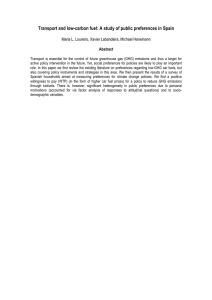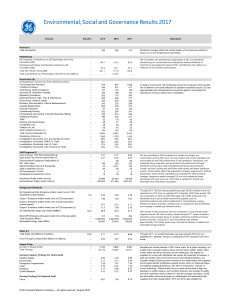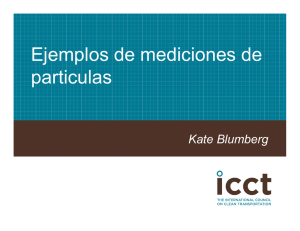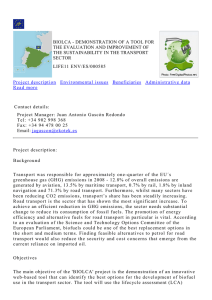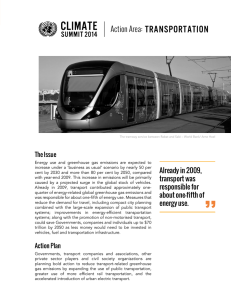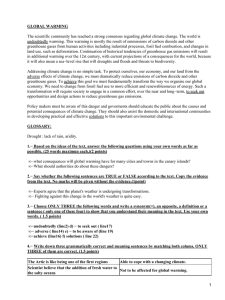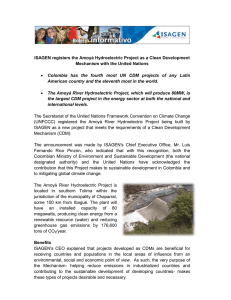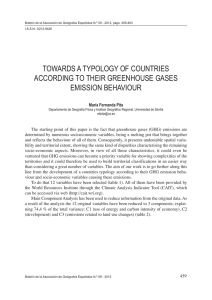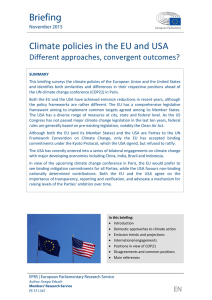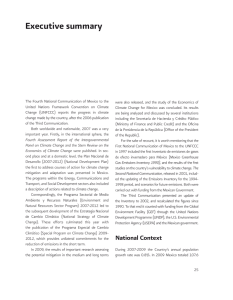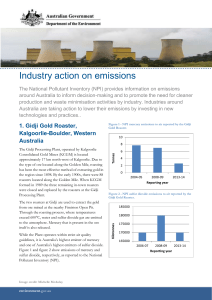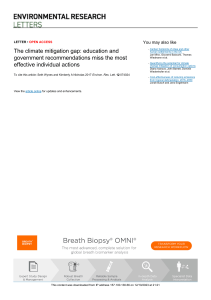Food and Greenhouse Gas (GHG) Emissions
Anuncio
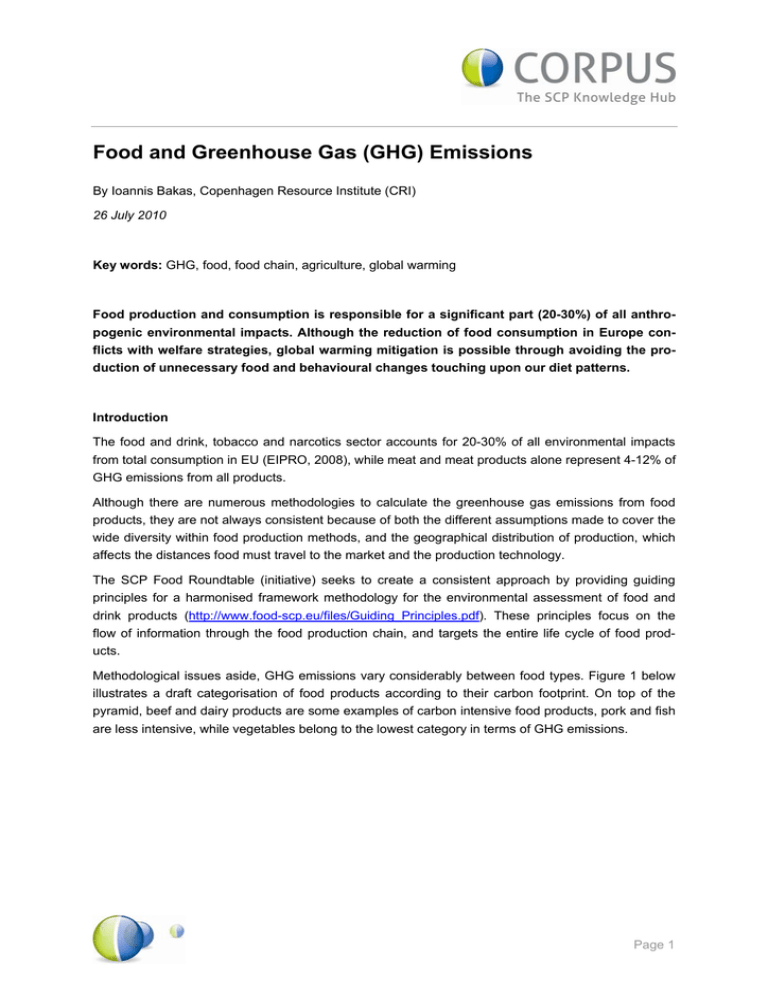
Food and Greenhouse Gas (GHG) Emissions By Ioannis Bakas, Copenhagen Resource Institute (CRI) 26 July 2010 Key words: GHG, food, food chain, agriculture, global warming Food production and consumption is responsible for a significant part (20-30%) of all anthropogenic environmental impacts. Although the reduction of food consumption in Europe conflicts with welfare strategies, global warming mitigation is possible through avoiding the production of unnecessary food and behavioural changes touching upon our diet patterns. Introduction The food and drink, tobacco and narcotics sector accounts for 20-30% of all environmental impacts from total consumption in EU (EIPRO, 2008), while meat and meat products alone represent 4-12% of GHG emissions from all products. Although there are numerous methodologies to calculate the greenhouse gas emissions from food products, they are not always consistent because of both the different assumptions made to cover the wide diversity within food production methods, and the geographical distribution of production, which affects the distances food must travel to the market and the production technology. The SCP Food Roundtable (initiative) seeks to create a consistent approach by providing guiding principles for a harmonised framework methodology for the environmental assessment of food and drink products (http://www.food-scp.eu/files/Guiding_Principles.pdf). These principles focus on the flow of information through the food production chain, and targets the entire life cycle of food products. Methodological issues aside, GHG emissions vary considerably between food types. Figure 1 below illustrates a draft categorisation of food products according to their carbon footprint. On top of the pyramid, beef and dairy products are some examples of carbon intensive food products, pork and fish are less intensive, while vegetables belong to the lowest category in terms of GHG emissions. Page 1 FOOD AND GHG EMISSIONS Fig. 1 Food product groups and GHG emissions Source: adapted from Danmarks Tekniske Universitet and Lyngby-Taarbaek Community Emissions from food consumption can be traced through all stages of the food chain: agriculture, food manufacturing, distribution and retail, consumption and end-of-life treatment (see KU on Food Waste). Agriculture Emissions from agriculture are in the form of methane from, for example, the cultivation of rice and enteric fermentation of livestock. The IPCC in its 4th Assessment Report estimated the emissions stemming directly from agriculture to be 10-12% of total anthropogenic emissions (IPCC, 2007). This figure does not include the emissions related to land use transformation (e.g. from forests to cultivated land). Among the possible solutions for reducing agricultural impacts is improved and more efficient land management and restoration of soils and degraded lands (IPCC, 2007). The IPCC estimates the technical mitigation potential to be about ~5500-6,000 MtCO2-equivalents per year, i.e., only slightly less than the total emissions from the USA in 2008. The concept of sustainable agriculture offers many possibilities for GHG emissions reduction through, for example, the use of agricultural residues, a renewable material, for energy generation. More tips and actions are listed in the Sustainable Agriculture Research and Education website (http://www.sare.org/publications/whatis/whatis.pdf). Emission per chain stage A recent publication by the European Commission maps all available recent studies on GHG emissions from food (EC, 2010). The results are presented per food chain stage in Table 1. All studies found the manufacturing stage to be responsible for most of the GHG emissions. This stage includes a host of very different activities for different food products such as food processing, packaging and transport (for GHG and food waste see KU “Food Waste”). Page 2 BY IOANNIS BAKAS, CRI Tab. 1 GHG emissions per food chain stage Stage t CO2-eq/t of food Agriculture Manufacturing 0.42 ETC/SCP, 2009 (NAMEA) 1.95 (including agriculture) WRAP, 2010 2.29 (including agriculture) Ecodesign Workplan (2010, EIPRO data) 1 Distribution and retail Consumption End-of-life Source: Source ETC/SCP, 2009 (NAMEA) 0.8 WRAP, 2010 0.1 ETC/SCP, 2009 (NAMEA) 0.6 WRAP, 2010 0.3 ETC/SCP, 2009 (NAMEA) 0.45 WRAP, 2010 EC, 2010, unpublished Mitigation recommendations The options for reducing the climate impact from food consumption can be divided mainly into preventing food waste and dietary change. The logic behind the first is an effort to reduce unnecessary production of food, while diet changes aim at reducing the consumption of carbon intensive food products such as meat (mainly beef) and dairy products. Part of the GHG emissions come from food that is produced but not eaten, so most of the initiatives across the EU focus on food waste prevention, such as the UK campaigns “Love Food, Hate Waste” and FareShare or the Fish Chips Danish product which uses otherwise inedible fish products. The problem with reducing GHG emissions and respective food waste prevention initiatives is the lack of robust data. This causes uncertainty in the emissions accounting and prohibits monitoring of the initiatives in terms of their effectiveness. Changes in behaviour and attitudes towards eating are also essential (Garnett, 2008). Reduced consumption of the most harmful food products and of products with low nutritional value, avoidance of food waste and eating only as much as necessary are actions that can reduce CO2 emissions from food consumption and simultaneously combat other environmental or social problems, such as obesity and food provision inequity. In fact, more sustainable diets are often in line with healthy diet recommendations by governmental authorities. A recent report by the EC Joint Research Centre shows that a diet change towards less meat intensive alternative diets can lead to a 2% decrease in the impacts of all EU-27 final consumption (Tukker et al, 2009). On the other hand, technical fixes in the meat and dairy industry is only capable of reducing (emissions) by about 20% (see also KU “Introducing behavioural changes”). Page 3 FOOD AND GHG EMISSIONS Other activities with mitigation include: reducing food miles, as locally produced food avoids all the transport-based emissions of imported food (http://www.worldwatch.org/node/6064); including agriculture in the Emissions Trading Schemes together with reduction targets; increasing consumption of organic goods (this should, however, be carefully interpreted as there is no concrete correlation between organic food and food responsible for low GHG emissions (Niggli et al, 2007). Scientific References DeWeerdt S. Is Local Food Better? Worldwatch Institute 2008. http://www.worldwatch.org/node/6064 European Commission, 2010. Assessment of the options to improve the management of bio-waste in the European Union. ARCADIS Project number 11/004759. http://ec.europa.eu/environment/waste/compost/pdf/ia_biowaste%20-%20final%20report.pdf European Commission, 2010 unpublished. Preparatory study on food waste across EU27. Final Report by Biontelligence Service European Topic Centre on Sustainable Consumption and Production, 2009. Environmental Pressures from European Consumption and Production; A study in integrated environmental and economic analysis. ETC/SCP Working Paper 1/2009. http://scp.eionet.europa.eu/publications/working%20paper%20namea2009/wp/working%20pa per%20namea2009 Garnett T., 2008. Cooking up a storm: Food, greenhouse gas emissions and our changing climate. Food Climate Research Network, Centre for Environmental Strategy, University of Surrey. September 2008. http://www.fcrn.org.uk/fcrnPublications/publications/PDFs/CuaS_web.pdf Joint Research Centre (JRC) , 2006. Environmental Impact of Products (EIPRO). Analysis of the life cycle environmental impacts related to the final consumption of the EU-25. European Commission’s Joint Research Centre, Institute for Prospective Technological Studies. EUR 22284 EN-2006 Niggli U., Leifert C., Alföldi T., Lück L., Willer H. ( Eds. ), 2007. Improving Sustainability in Organic and Low Input Food Production Systems. Proceedings of the 3rd International Congress of the European Integrated Project Quality Low Input Food (QLIF). University of Hohenheim, Germany, March 20 – 23, 2007. Research Institute of Organic Agriculture FiBL, CH-Frick. (2007) Smith P., Martino D., Cai Z., Gwary D., Janzen H., Kumar P., McCarl B., Ogle S., O’Mara F., Rice C., Scholes B., Sirotenko O., 2007. Agriculture. In Climate Change 2007: Mitigation. Contribution of Working Group III to the Fourth Assessment Report of the Intergovernmental Panel on Climate Change [B. Metz, O.R. Davidson, P.R. Bosch, R. Dave, L.A. Meyer (eds)], Cambridge University Press, Cambridge, United Kingdom and New York, NY, USA Tukker A., Bausch-Goldbohm S., Verheijden M., de Koning A., Kleijn R., Wolf O., Dominguez I. P., 2009. Environmental impacts of diet changes in the EU. European Commission’s Joint Research Centre, Institute for Prospective Technological Studies. EUR 23783 EN-2009 Page 4 BY IOANNIS BAKAS, CRI Other Documents FAO, 2010. Greenhouse Gas Emissions from the Dairy Sector: a Life Cycle Assessment. Food and Agriculture Organisation of the United Nations, Animal Production and Health Division. http://www.fao.org/docrep/012/k7930e/k7930e00.pdf Websites European Food Sustainable Consumption and Production Round Table at: http://www.food-scp.eu/ FareShare food redistribution initiative at: http://www.fareshare.org.uk/ Food carbon calculator at: http://www.foodcarbon.co.uk/ Food carbon calculator at: http://www.eatlowcarbon.org/ Food carbon footprint at: http://www.fvm.dk/Foods_Carbon_Footprint.aspx?ID=42268 LCA food database at: http://www.lcafood.dk/ “Love food, hate waste” campaign at: http://www.lovefoodhatewaste.com/ Sustainable Agriculture Research and Education at: http://www.sare.org/ Page 5
